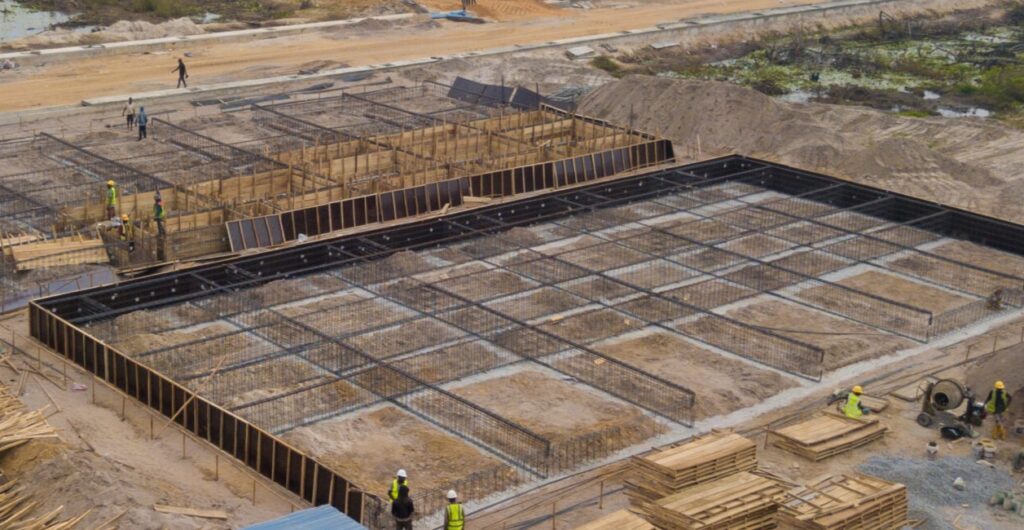Damp-proof courses (DPCs) are barriers usually made of materials like bitumen or plastic that are usually installed horizontally in the walls of buildings near ground level to prevent moisture from rising into the structure.
They are a critical element in building construction, particularly in areas prone to moisture intrusion.
In this article, we will delve into the significance of DPCs, their types, materials, installation methods, and maintenance practices.
Types of DPC in Construction
Two types of DPCs serve complementary roles in moisture management within buildings, ensuring comprehensive protection against dampness and related structural issues.
- Vertical DPCs:
Cavity walls install Vertical DPCs vertically within the wall structure to prevent lateral moisture penetration, especially in areas with heavy rainfall or high groundwater levels. - Horizontal DPCs:
Horizontal DPCs are usually installed horizontally in walls between the foundation and the first course of bricks or blocks at ground level to prevent moisture from rising through capillary action, creating a physical barrier against moisture and protecting the structure from dampness and associated issues like mold growth and decay.

Installation Process of DPC
In construction, the installation of damp proof courses (DPCs) is a critical process to prevent moisture intrusion into buildings and the installation methods for DPC vary based on the type of DPC being installed and the specific requirements of the construction project.
For horizontal DPCs:
- Typically installed during the construction of walls, between the foundation and the first course of bricks or blocks,.
- We lay the DPC material, such as bitumen membranes or plastic sheets, horizontally across the width of the wall to ensure complete coverage.
- We take care to ensure proper bonding of the DPC material to the masonry or concrete substrate to create an effective moisture barrier.
For vertical DPCs:
- Installed within cavity walls to prevent lateral moisture penetration.
- The DPC material is laid vertically, ensuring complete coverage.
- Care is taken to ensure proper bonding of the DPC material to the masonry or concrete substrate.
Importance of Proper Installation
Proper installation techniques ensure the effectiveness and longevity of the DPC, minimizing the risk of moisture-related issues in the building.
In complex construction projects, the installation of DPCs may require the expertise of qualified contractors or specialists. Trained professionals install DPCs correctly, addressing potential challenges such as irregular wall surfaces, corners, and junctions.
Materials Used in DPCs:
Detail the various materials employed in DPC construction, including:
- Bitumen membranes are flexible sheets that provide an effective moisture barrier.
- Plastic sheets are durable and cost-effective barriers commonly used in horizontal DPCs.
- Chemical barriers: We inject liquids into masonry to create an impermeable barrier against moisture.
Importance of DPCs
In construction, Damp Proof Courses (DPCs) play a crucial role in protecting buildings from moisture-related issues.
- Moisture Intrusion: Moisture infiltration is a common problem in buildings, leading to issues such as mold growth, decay of building materials, and deterioration of structural integrity.
- Preventing Rising Dampness: DPCs act as barriers to prevent moisture from rising through walls via capillary action, a phenomenon known as rising dampness.
- Structural Integrity: By preventing moisture penetration, DPCs help to maintain the structural integrity of buildings, ensuring their longevity and durability.
- Health Concerns: Dampness in buildings can create unhealthy living conditions, contributing to respiratory problems and allergies. DPCs help to mitigate these health risks by keeping indoor environments dry.
- Many building codes and regulations mandate the installation of DPCs in construction projects to comply with standards for moisture control and building durability.
- Cost Savings: Properly installed DPCs can save costs associated with repairing moisture-related damage, reducing the need for extensive renovations or remediation in the future.
- Building Material Protection: DPCs not only protect against rising dampness but also safeguard building materials such as timber, concrete, and masonry from moisture-induced deterioration. This preservation extends the lifespan of the building components.
- Energy Efficiency: Moisture infiltration can compromise the thermal performance of buildings, leading to increased energy consumption for heating and cooling. DPCs help structures maintain their thermal efficiency by preventing heat loss through damp walls.
- Aesthetic Preservation: Dampness in walls can cause unsightly stains, peeling paint, and plaster deterioration, detracting from interiors’ aesthetic appeal. DPCs help preserve buildings’ appearance by preventing moisture-related damage.
- Insurance Requirements: Insurance providers may require proof of DPC installation to assess the risk of water damage in buildings. Compliance with DPC standards can facilitate insurance coverage and mitigate liability for property owners.
- In the real estate market, properties with effective moisture control measures, including properly installed DPCs, command higher resale values. Potential buyers are more inclined to invest in buildings with a reduced risk of moisture-related issues.
The Difference Between DPC and DPM
- DPC (Damp Proof Course): This is a barrier through the structure by capillary action, such as through the mortar beds. Damp-proof courses are typically installed at the base of building walls (above ground level) to prevent rising damp, which is the upward movement of moisture through walls and floors from the ground. Flexible materials, such as plastic, bituminous felt, or metal sheets, are commonly used for DPCs.
- The DPM (Damp Proof Membrane): Serves as a barrier against the transmission of moisture. A DPM is typically a thick plastic sheet placed under the concrete slab of a building to prevent moisture from penetrating from the ground into the floor slab. DPMs are crucial for preventing damp from affecting floor coverings and for making buildings more comfortable and free from moisture-related issues.
| Feature | DPC (Damp Proof Course). | DPM (Damp-Proof Membrane) |
| Purpose | Prevents dampness in walls. | Prevents moisture from entering floor slabs. |
| Placement | Installed at the base of walls, above ground level. | Placed under the concrete floor slabs. |
| Material Type | Typically made from flexible materials like plastic, bituminous felt, or metal sheets,. | Usually a thick plastic sheet. |
| Function | Blocks water from rising through capillary action in walls. | Acts as a barrier to moisture from the ground. |
| Impact | Protects the integrity of walls and prevents damage to the building’s masonry. | It keeps floor coverings dry and improves indoor air quality by preventing mold growth. |
Both DPC and DPM are critical in construction for effectively managing moisture to protect the building’s structural integrity and ensure a healthier indoor environment.
Maintenance and Practicality
By prioritizing regular maintenance and inspection of DPCs, you can proactively address moisture issues, preserve the structural integrity of buildings, and promote occupant health and comfort. You can do this by:
- Regular Inspection: Regularly inspect your DPCs, as it is essential to detect any signs of damage, deterioration, or breaches in the moisture barrier. Periodically conduct inspections, particularly after extreme weather events or significant structural work.
- Weep Hole Clearance: If your building has weep holes at the base of the walls to drain accumulated moisture, make sure they are free of obstructions like debris, vegetation, or soil buildup. Blocked weep holes impede drainage and can exacerbate moisture problems.
- Crack Repair: Inspect the walls for cracks or gaps that could compromise the DPC’s integrity. Seal any cracks promptly to prevent water ingress and ensure the effectiveness of the moisture barrier.
- Drainage Maintenance: Make sure there is proper drainage around the building to prevent water from pooling near the foundation or walls. Address any grading issues, install gutters and downspouts, and divert surface water away from the structure.
- Professional Assessment: Seek the expertise of qualified building professionals or contractors when suspecting DPC damage or deterioration. They can conduct thorough assessments, identify the root cause of moisture issues, and recommend appropriate remedial measures.
In conclusion, dampproof courses play a vital role in protecting buildings from moisture-related damage. Understanding the types, materials, installation methods, and maintenance practices associated with DPCs allows you to ensure the durability and longevity of your structures in various environmental conditions.
FAQs
DPCs are crucial for defending buildings against moisture-related problems like mold growth, material deterioration, and dampness-induced structural damage.
Yes, many building codes and regulations mandate the installation of DPCs in construction projects to comply with standards for moisture control and building durability.
DPCs help maintain buildings’ structural integrity, preserve building materials, improve energy efficiency, improve indoor air quality, and protect against moisture-related health hazards, thereby contributing to the overall performance and longevity of the structure.
Yes, qualified building professionals or contractors can often repair or replace damaged DPCs. The appropriate remedial measures depend on the extent of the damage and the underlying cause of moisture issues.



Leave a Reply